Journal-isms will appear infrequently until the end of February, while its author is on vacation.
‘Tremendous Interest’; Valued at $1.2 Million+
Jeffries Drops Biggie Into Impeachment Trial
Keith Woods Named NPR Chief Diversity Officer
Year-Long Collaboration to Focus on Latino Vote
Pressley Chooses The Root to Reveal Hair Loss
CNN’s Abby Phillip Criticized After Debate
Site Lists Latino Columnists We Should Watch
Lehrer Left Behind a Set of Principles
Jaramogi, Nance, Pruitt, Rogers Among Passings
Short Takes
“

‘Tremendous Interest’; Valued at $1.2 Million+
“Last year, Johnson Publishing, the parent company behind Ebony and Jet magazines, filed for liquidation, ending the historic enterprise’s 77-year run. By July, a quartet of foundations teamed up at the 11th hour to purchase the company’s historic archives of images, video, and audio recordings,” Taylor Dafoe reported Jan. 3 for artnet News.
“But the fate of the artwork that adorned the company’s famous headquarters in downtown Chicago — including pieces by Carrie Mae Weems, Henry Ossawa Tanner, and Kenneth Victor Young — remained less certain.
“Now, those works are set to be sold. On January 30, Swann Galleries in New York will host a sale dedicated to the painting, sculptures, etchings, and other objects by 75 African American artists featured in Johnson’s offices. A free-and-public exhibition held five days prior to the sale will mark the first time these works will have been shown outside of the company. . . .”
Alexandra Nelson, communications director for the Swann Auction Galleries, told Journal-isms Thursday there is “tremendous interest” in the auction. The gallery generally has 70 people in the room bidding for African American art, and more will be bidding online.
Dafoe also wrote, “On the walls hung a number of notable works that, later this month, will make their way to New York for the auction: an installation of seven framed photographs with etched glass by Carrie Mae Weems (estimated to go for $100,000 to $150,000 at Swann’s sale); a crepuscular canvas from 1912 by Henry Ossawa Tanner ($150,000 to $250,000); bronze busts by Richmond Barthé and Elizabeth Catlett (both estimated at $50,000 to $75,000); and many others. . . .”
Robert Channick wrote Jan. 2 in the Chicago Tribune:
“The collection, which includes works by both famous and lesser-known African American artists, is valued at upwards of $1.2 million. The auction proceeds will be used to pay back former CEO Desiree Rogers for $2.7 million in loans she made to Johnson Publishing and other secured claims against the company, pending approval next week from a Chicago federal bankruptcy judge.
“ ‘Desiree will have the first cut at the art auction proceeds,’ said Neville Reid, a Chicago bankruptcy attorney representing the trustee. . . .”
Judge Jack B. Schmetterer agreed on Jan. 8, saying Rogers and Linda Johnson Rice, daughter of company founders John H. and Eunice Johnson, are entitled to their claims if there are no challenges by Feb. 14.

Jeffries Drops Biggie Into Impeachment Trial
“On Tuesday night, Rep. Hakeem Jeffries (D-NY) dropped a lyrical bomb on the Senate floor during President Trump’s impeachment trial,” Marlow Stern wrote Wednesday, updated Thursday for the Daily Beast.
“In response to a query by Trump lawyer Jay Sekulow, Jeffries, who hails from Brooklyn, New York, responded by shouting-out Brooklyn’s finest: ‘We are here, sir, to follow the facts, apply the law, be guided by the Constitution, and present the truth to the American people. That is why we are here, Mr. Sekulow, and if you don’t know, now you know.’ (The line comes from the Notorious B.I.G. classic ‘Juicy.’)
“ ‘Ohhhh! And if you don’t know, now you know!’ exclaimed The Daily Show’s Trevor Noah on Wednesday night. ‘That’s right! Congressman Hakeem Jeffries just quoted Biggie on the floor of Congress. The only thing I wish is that he’d used the entire line. That would have been amazing. He’s like, ‘If you don’t know, now you know, n*ggaaaaa!’ because if that happened, black people would have been out celebrating in the streets, it would have been MLK Day Part II. ‘” . . .”
- Tim Giago, indianz.com: How many clowns can one fit into the Senate car?
- Dahleen Glanton, Chicago Tribune: Democrats at Trump’s impeachment trial should listen to the chief justice. No more ‘pettifogging.’
- Juan Williams, the Hill: Counting the votes to remove Trump
Keith Woods Named NPR Chief Diversity Officer
Keith Woods, NPR’s vice president of newsroom training and diversity, has been promoted to the newly created position of position of chief diversity officer, NPR announced Thursday.
“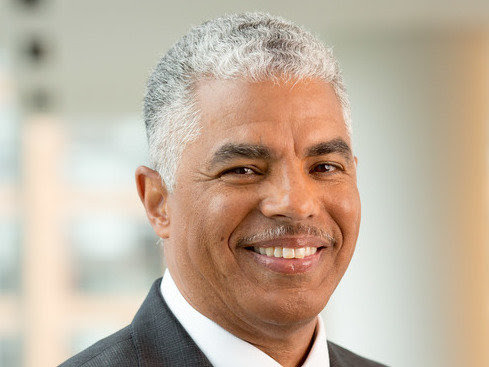 As a part of the executive leadership team, Woods (pictured; photo by Allison Shelley) will guide NPR’s push to expand the diversity of its audience across NPR and help build a more diverse and inclusive organization, an announcement said.
As a part of the executive leadership team, Woods (pictured; photo by Allison Shelley) will guide NPR’s push to expand the diversity of its audience across NPR and help build a more diverse and inclusive organization, an announcement said.
“I want NPR to reflect diversity, equity, and inclusion in everything we do. As an organization we should be leaders in providing news and cultural programming that speaks to our richly diverse country and connects with an audience that looks and sounds like America – all while creating a welcoming and supportive workplace for all,” NPR CEO John Lansing said in the announcement, echoing sentiments of his recent predecessors.
Lansing said he was promoting Woods “To elevate and expand the role of diversity in our thinking and in our work,” and said Woods would be “a thought partner to me and the rest of the executive team, helping us set goals and craft a diversity plan that is responsive to – and accountable to – our staff and the public we serve.”
Woods will report directly to the CEO and continue his leadership and advising roles in key areas. His team will grow to support that work, the announcement said.
Woods came to NPR in 2010 “to lead the organization’s diversity strategy and has worked with the newsroom on a multi-year effort to increase the diversity of sources. He has trained the staffs of more than 30 public media stations from Canton, New York, to Juneau, Alaska. Before joining NPR, Woods was Dean of Faculty of The Poynter Institute, a school for journalists in St. Petersburg, Florida. . . .”

Year-Long Collaboration to Focus on Latino Vote
“The World,” the daily global news and analysis program from PRX, WGBH, and the BBC, Tuesday announced “Every 30 Seconds,” a collaborative public media reporting project tracing the young Latino electorate ahead of the 2020 national election.
Funded by a $300,000 grant from the Corporation for Public Broadcasting, ‘Every 30 Seconds’ will report on the “issues, influences, concerns, and challenges driving decision-making and turnout among young Latino voters across the United States,” the announcement continued.
“According to a recent count, approximately every 30 seconds, a Latino citizen in the United States reaches voting age (18). Further, 32 million Latinos are projected to be eligible to vote in 2020, up from 2016 and now one of the largest shares of nonwhite voters. Through deep engagement within communities and among Latino voters, ‘Every 30 Seconds’ will delve into the complexities of demographics, language, law, and inequities within political systems.
“This year-long project will launch in February with regular broadcasts on ‘The World’ accompanied by digital components. From its newsroom in Boston, ‘The World’ and Senior Editor Daisy Contreras will lead production of stories for national broadcast in partnership with public radio stations across the country. Digital Editor Tania Karas will lead production of digital stories and interactives. . . .”
Contributing stations include KERA in Dallas; KJZZ in Phoenix; PBS in San Diego, Calif.; KUOW in Seattle; WABE in Atlanta; WLRN in Miami and WUNC in Chapel Hill, N.C.
- Brittany Shepherd, Yahoo News: Bloomberg pledges $70 billion to bolster black America in new plan
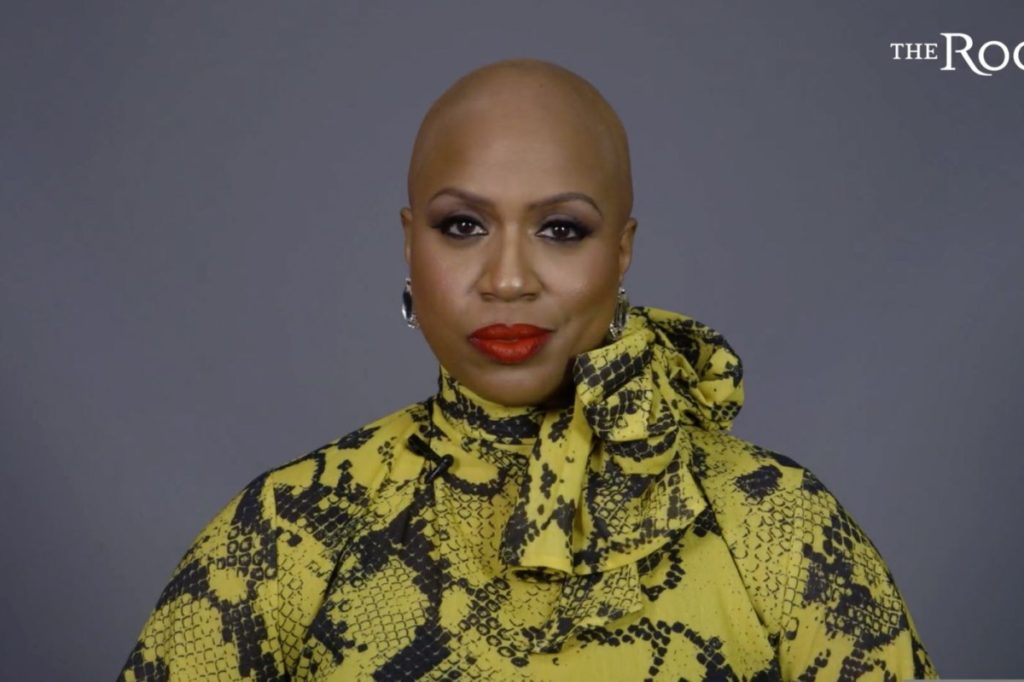
Pressley Chooses The Root to Reveal Hair Loss
Last week, many women “who suffer from the autoimmune disorder that causes hair loss watched U.S. Rep. Ayanna Pressley’s emotional video on the Root about the condition that’s left her bald,” Elizabeth Wellington wrote Tuesday for the Philadelphia Inquirer. “Some cried, some nodded in understanding. And all of them felt relieved. Here was someone giving a public voice to an often-private suffering.
“Pressley, a 45-year-old Democrat from Massachusetts, is known in fashion and political circles for her elegant Senegalese twists, extensions that matched the texture of her own hair.
“Those long twists, Pressley says in the seven-minute video, weren’t just a part of her personal identity. They helped define her political brand. Not to mention, she always heard from girls she inspired to be proud of the hair God gave them. That says a lot in a world that puts a premium on little black girls having long, straight hair. But now, with alopecia, there wasn’t any hair in which to even attach the two-strand-twist extensions anymore.
“So, last Thursday, wearing a stunning black-and-gold blouse, Pressley informed us of her new reality as a bald woman.”
Danielle Belton, editor of the Root, explained to Journal-isms Wednesday by email, “We were approached by Pressley’s people about her doing a reveal with The Root about her losing her hair to alopecia.
“This was thanks to my intrepid staff, who has worked with Pressley on various stories on The Root over the past year, in particular, staff writer Anne Branigin, who wrote about Pressley’s iconic Senegalese twists, and my video team, including producer Jessica Moulite (who also detailed her own struggle with hair loss in a follow-up story) and my senior video producer Ashley Velez.
“We were honored that Pressley [entrusted] The Root with this very sensitive and important story. It was an honor to bring this video to fruition of her telling her own story, in her own words for our video series ‘A Word.’ It was a powerful and affirming experience for all.”
CNN’s Abby Phillip Criticized After Debate
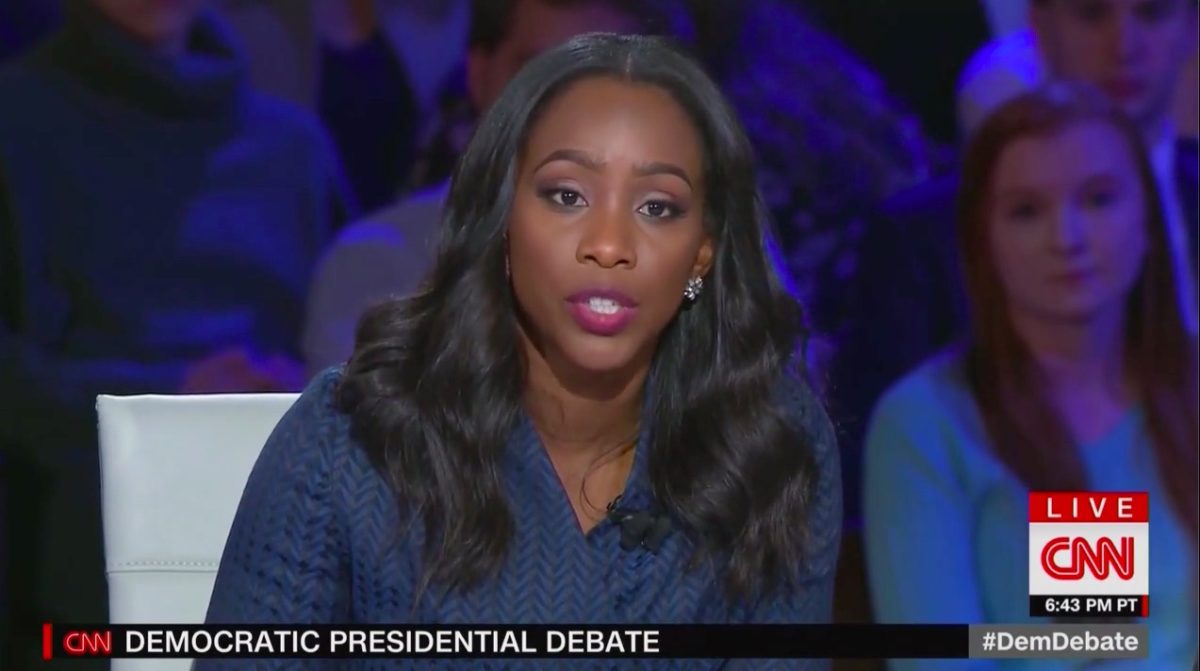 The final Democratic presidential debate before the Feb. 3 Iowa caucuses saw CNN moderator Abby Phillip (pictured) criticized for her performance.
The final Democratic presidential debate before the Feb. 3 Iowa caucuses saw CNN moderator Abby Phillip (pictured) criticized for her performance.
“It wasn’t long, however, before attention turned to the ‘sizzling feud’ (CNN’s words) that dominated coverage in the run-up to the debate: the claim — reported by CNN, then made by [Sen. Elizabeth] Warren herself — that [Sen. Bernie] Sanders privately told Warren that a woman can’t win the White House in 2020,” Jon Allsop reported for Columbia Journalism Review.
Joe Concha added for the Hill, “Critics of the exchange, including some members of the media, argued that it was unfair for Phillip to frame the question to Warren that presented as fact that Sanders had said a woman couldn’t win the White House. The criticism came from media commentators such as NPR’s David Folfenflik and National Review’s Rich Lowry.”
- John Kass, Chicago Tribune: CNN’s shameful treatment of Bernie Sanders (Jan. 16)
- Jim Naureckas and Julie Hollar, Fairness & Accuracy In Reporting: The Big Loser in the Iowa Debate? CNN’s Reputation (Jan. 15)
- Molly Roberts, Washington Post: No one has to be the liar (Jan. 16)
- Matt Taibbi, Rolling Stone: CNN’s Debate Performance Was Villainous and Shameful (Jan. 15)

Site Lists Latino Columnists We Should Watch
While the attention of the rest of us was elsewhere, the website remezcla.com has been compiling lists of Latino journalists we should be watching.
“Journalism is overwhelmingly white,” Yara Simón wrote for the site seven months ago. “As a matter of fact, a 2018 Pew Research Center analysis found that 77 percent of newsroom employees – those working in newspapers, broadcasting, and internet publishing – were non-Hispanic whites.
“This makes newsroom employees less diverse than other parts of the US workforce, which means that we don’t always have representation in media or ownership of our stories. In an industry that still hasn’t figured out how to embrace people of color, it’s then not surprising that it’s difficult to find enough Latinos [as] columnists.
“But they definitely do exist, and they’re writing about everything from niche subjects to detailed accounts of our histories, all the while weighing in on the topics that dominate national headlines. Below, check out eight Latino columnists that should be on your radar. . . . “
John Paul Brammer, who answers “life’s queerest questions”
Nubia Willman, immigration lawyer
Gary Suarez, who writes about Latin trap music
Concepción de León, culture writer, contributing to El Espace in the New York Times
Yesika Salgado, columnist on sex and relationships
Esther J. Cepeda, nationally syndicated Chicago-based columnist.
Nancy Flores, Latino culture in Austin, Texas
Ilyanna Maisonet, San Francisco food columnist
- Christina Noriega, remezcla.com: 10 Latino Photographers Documenting Underrepresented Communities (Aug 30, 2018)
- Alejandra Oliva, remezcla.com: 15 Books by Latino & Latin American Authors to Add to Your 2020 Reading List
- Yara Simón, remezcla.com: 6 Central American Journalists You Need to Be Following for Nuanced Immigration Coverage (seven months ago)
Lehrer Left Behind a Set of Principles
Lehrer left behind a statement of his journalistic principles, and he was shown reading them in the on-air tributes:
“Do nothing I cannot defend.
“Cover, write and present every story with the care I would want if the story were about me.
“Assume there is at least one other side or version to every story.
“Assume the viewer is as smart and caring and good a person as I am.
“Assume the same about all people on whom I report.
“Assume personal lives are a private matter until a legitimate turn in the story absolutely mandates otherwise.
“Carefully separate opinion and analysis from straight news stories and clearly label everything.
“Do not use anonymous sources or blind quotes except on rare and monumental occasions. No one should be allowed to attack another anonymously.
“I am not in the entertainment business.”
Jaramogi, Nance, Pruitt, Rogers Among Passings
- “Heshimu Jaramogi (pictured below), 67, a veteran journalist who worked in radio, published the Neighborhood Leader newspaper, and once served as president of the Philadelphia Association of Black Journalists, died of cancer Tuesday, Jan. 14, at his home in Philadelphia,” Valerie Russ reported Jan. 17 for the Philadelphia Inquirer.
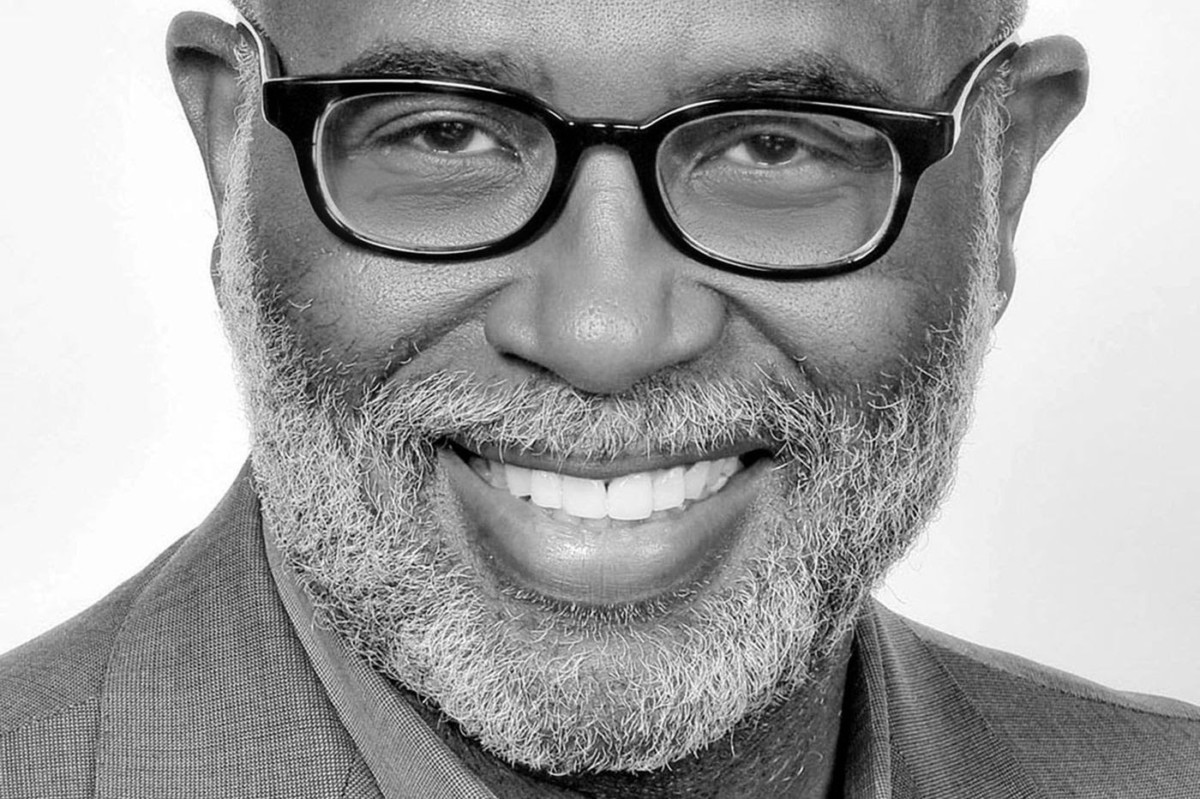 Michael Days, vice president for diversity and inclusion at The Inquirer, said, “Heshimu was a remarkable human being, a terrific journalist, and entrepreneur who was multitasking on all kinds of platforms long before most of us had a clue. And he did not do drive-by conversations. They were usually nuanced and thoughtful and designed to make you think deeply about your own positions, and maybe challenge yourself. Through it all, there would usually be a lot of laughter involved. He’s been my brother for almost 35 years. It’s going to take me more than a minute to make peace with his passing.”
Michael Days, vice president for diversity and inclusion at The Inquirer, said, “Heshimu was a remarkable human being, a terrific journalist, and entrepreneur who was multitasking on all kinds of platforms long before most of us had a clue. And he did not do drive-by conversations. They were usually nuanced and thoughtful and designed to make you think deeply about your own positions, and maybe challenge yourself. Through it all, there would usually be a lot of laughter involved. He’s been my brother for almost 35 years. It’s going to take me more than a minute to make peace with his passing.”
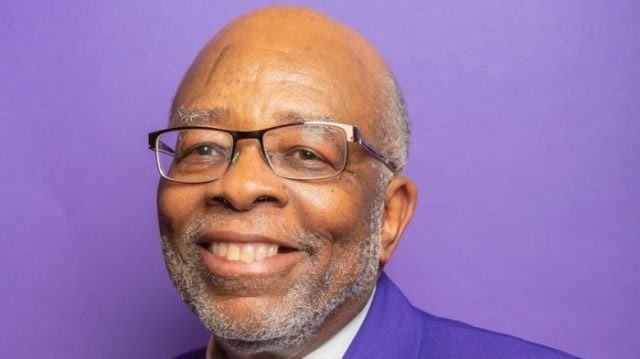 Roscoe Nance (pictured) was the Clarion Ledger’s first Southwestern Athletic Conference (SWAC) reporter, the paper’s first black sportswriter and a journalist later known around the country as the dean of black college sportswriters,” Jimmie E. Gates reported Jan.10 for the Clarion Ledger in Jackson, Miss., updated Jan. 11. “The retired USA Today NBA reporter and SWAC Hall of Famer died Thursday of cancer at his Virginia home, according to family members. He was 71. . . .”
Roscoe Nance (pictured) was the Clarion Ledger’s first Southwestern Athletic Conference (SWAC) reporter, the paper’s first black sportswriter and a journalist later known around the country as the dean of black college sportswriters,” Jimmie E. Gates reported Jan.10 for the Clarion Ledger in Jackson, Miss., updated Jan. 11. “The retired USA Today NBA reporter and SWAC Hall of Famer died Thursday of cancer at his Virginia home, according to family members. He was 71. . . .”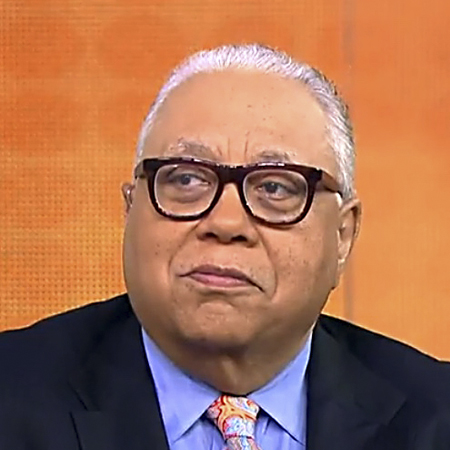 Steven Lawrence Pruitt (pictured), a senior partner in Watts Partners, creators of the forthcoming Black News Channel, died Jan. 15 in Washington, D.C., his daughter, Maya Pruitt, told Journal-isms. He was 70. She said the family did not know the official cause of death. “He was an amazing man who did everything with his whole heart. He was dedicated to all things political and was extremely knowledgeable about all things political. He was a mentor to many younger generations on and off of Capitol Hill,” she said. Pruitt held several positions on Capitol Hill, worked for the United Negro College Fund and headed his own consulting firm. Services are Jan. 30 at 10 a.m. at Metropolitan Baptist Church, 1200 Mercantile Lane, Largo, MD 20774.
Steven Lawrence Pruitt (pictured), a senior partner in Watts Partners, creators of the forthcoming Black News Channel, died Jan. 15 in Washington, D.C., his daughter, Maya Pruitt, told Journal-isms. He was 70. She said the family did not know the official cause of death. “He was an amazing man who did everything with his whole heart. He was dedicated to all things political and was extremely knowledgeable about all things political. He was a mentor to many younger generations on and off of Capitol Hill,” she said. Pruitt held several positions on Capitol Hill, worked for the United Negro College Fund and headed his own consulting firm. Services are Jan. 30 at 10 a.m. at Metropolitan Baptist Church, 1200 Mercantile Lane, Largo, MD 20774.
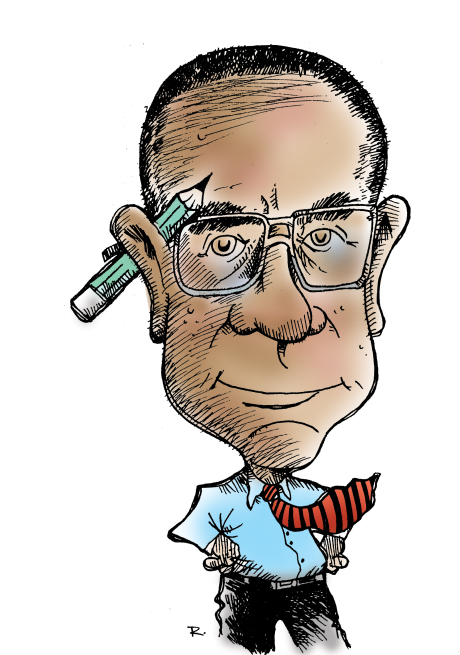 Ron Rogers (sketch by himself), who while at the South Bend (Ind.) Tribune in the early 2000s was the only African American staff editorial cartoonist at a daily newspaper, died Jan. 7 after a heart attack, his wife, Donna Whitaker Rogers, told Journal-isms. He was 65. “At the time [of] his death, he was producing political cartoons as a freelancer. He also produced a blog at www.getintoon.wordpress.com/,” according to the family obituary. He later was political cartoonist for The Chronicle of Winston-Salem, N.C., where his wife was managing editor.
Ron Rogers (sketch by himself), who while at the South Bend (Ind.) Tribune in the early 2000s was the only African American staff editorial cartoonist at a daily newspaper, died Jan. 7 after a heart attack, his wife, Donna Whitaker Rogers, told Journal-isms. He was 65. “At the time [of] his death, he was producing political cartoons as a freelancer. He also produced a blog at www.getintoon.wordpress.com/,” according to the family obituary. He later was political cartoonist for The Chronicle of Winston-Salem, N.C., where his wife was managing editor.
Short Takes
- “In yet another sign that voters live in very different media bubbles,” a new NPR/PBS NewsHour/Marist Poll found that Democrats cited voter suppression as the greatest threat to the 2020 election, Brett Neely reported Tuesday for NPR. “Voter fraud topped the list for Republicans. Moreover, women and nonwhite respondents are considerably more likely than men and white voters to say that their own vote won’t be counted. . . .”
- “. . . As NPR’s Brett Neely notes, it is probably not surprising that 54% of Republicans said stopping the spread of disinformation is mainly the media’s responsibility, given President Donald Trump’s repeated claim that the media traffics in ‘fake news,’ ” Cristina Tardáguila, Daniel Funke and Susan Benkelman reported Thursday for the Poynter Institute. “In contrast, 29% of Democrats put the main onus on the media. . . .”
- With redesign of journal-isms.com accomplished, Journal-isms is seeking someone to maintain the site. Must be familiar with WordPress. Those interested may make contact via < https://www.journal-isms.com/contact/>.
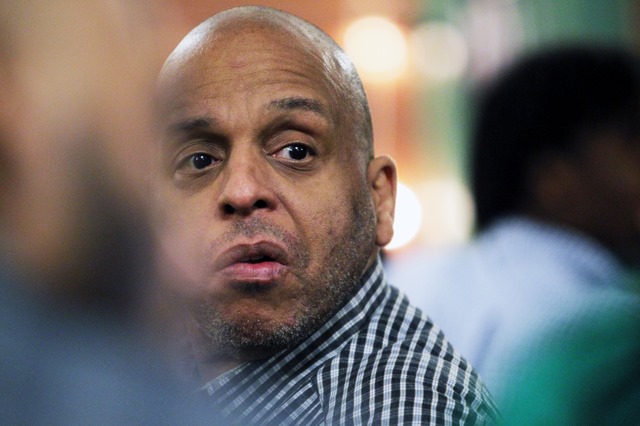 Todd Steven Burroughs, (pictured, by Sharon Farmer) Newark, N.J.-based public historian, media consultant, contractor, author and blogger, put out a call on Facebook Thursday for donations to Journal-isms Inc. as his birthday fundraiser. Burroughs called Journal-isms “mandatory reading for all journalists of color! . . . When Richard Prince quotes you (as he has me), you are a notable :)” He hopes to raise $1,000. Thanks, Todd!
Todd Steven Burroughs, (pictured, by Sharon Farmer) Newark, N.J.-based public historian, media consultant, contractor, author and blogger, put out a call on Facebook Thursday for donations to Journal-isms Inc. as his birthday fundraiser. Burroughs called Journal-isms “mandatory reading for all journalists of color! . . . When Richard Prince quotes you (as he has me), you are a notable :)” He hopes to raise $1,000. Thanks, Todd!
- My research “has found that some protest movements have more trouble than others in getting coverage that treats them and their issues seriously,” Danielle K. Kilgo, assistant professor at Indiana University, wrote Jan. 16 for the Conversation. “In a recent study, my co-author Summer Harlow and I looked at local and metropolitan newspaper coverage of protests. We found that narratives about the women’s march and anti-Trump protests gave voice to protesters and significantly explored their grievances. On the other end of the spectrum, protests about anti-black racism and indigenous people’s rights received the least legitimizing coverage. . . .”
 Manny Garcia (pictured) has been selected as the senior editor of a new investigative reporting initiative between ProPublica and The Texas Tribune, the organizations announced Jan. 16. “García will help build and manage a team of five reporters and other staffers based in the Tribune’s Austin, Texas, newsroom. García is currently the ethics and standards editor for the USA Today Network. He was previously the network’s East Region executive editor, overseeing more than 50 newsrooms. García is also the former editor of the Naples Daily News, editor and general manager of Spanish-language El Nuevo Herald and senior news editor of the Miami Herald. . . . ”
Manny Garcia (pictured) has been selected as the senior editor of a new investigative reporting initiative between ProPublica and The Texas Tribune, the organizations announced Jan. 16. “García will help build and manage a team of five reporters and other staffers based in the Tribune’s Austin, Texas, newsroom. García is currently the ethics and standards editor for the USA Today Network. He was previously the network’s East Region executive editor, overseeing more than 50 newsrooms. García is also the former editor of the Naples Daily News, editor and general manager of Spanish-language El Nuevo Herald and senior news editor of the Miami Herald. . . . ”
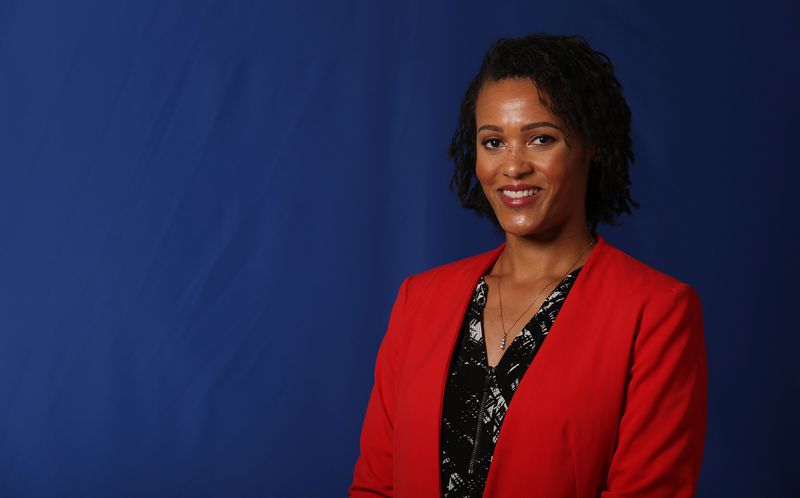
- Alden Global Capital recently bought a 32% stake in Tribune Publishing. Alden is “a hedge fund described by one Washington Post writer as ‘one of the most ruthless of the corporate strip-miners seemingly intent on destroying local journalism,’ Scott Maxwell wrote Jan. 17 for the Orlando Sentinel, a Tribune property. Maxwell was explaining why he is not accepting buyout offers. He quoted others at the Sentinel, such as Shannon Green, columnist and editorial board member, who “has seen her work change lives, like the time she wrote about a smart, young, poor man who couldn’t afford college — and a reader responded by paying his tuition. ‘That’s why some of us have stayed in a business that doesn’t always love us back,’ she said. . . .”
 “Longtime anchor Dunia Elvir (pictured) is off the air at Telemundo 52″ in Los Angeles, Veronica Villafañe reported Jan. 15 in her Media Moves column. “She last anchored a newscast at noon on Friday, January 10.” Villafañe also wrote, “Her removal from the anchor desk took place a week after she conducted an interview that aired January 3 with the president of a Los Angeles-based Salvadoran community organization under scrutiny. . . . Social media reaction to the interview was swift, accusing Elvir of asking ‘softball’ questions and of conflict of interest, because a line in her bio on the station’s website stated she is a member of the organization. That bio has been scrubbed from the website. . . .”
“Longtime anchor Dunia Elvir (pictured) is off the air at Telemundo 52″ in Los Angeles, Veronica Villafañe reported Jan. 15 in her Media Moves column. “She last anchored a newscast at noon on Friday, January 10.” Villafañe also wrote, “Her removal from the anchor desk took place a week after she conducted an interview that aired January 3 with the president of a Los Angeles-based Salvadoran community organization under scrutiny. . . . Social media reaction to the interview was swift, accusing Elvir of asking ‘softball’ questions and of conflict of interest, because a line in her bio on the station’s website stated she is a member of the organization. That bio has been scrubbed from the website. . . .”
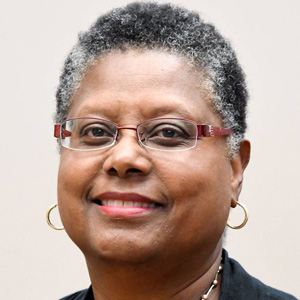 Sundra Hominik (pictured), most recently a senior editor for McClatchy Georgia, has joined the Baltimore Sun as content editor for magazines. She has been features editor at the News Journal in Wilmington, entertainment editor at the Daily Advertiser in Lafayette, La., executive editor for GateHouse Media Delaware in Dover, Del., and senior editor/information at the Richmond (Va.) Times-Dispatch.
Sundra Hominik (pictured), most recently a senior editor for McClatchy Georgia, has joined the Baltimore Sun as content editor for magazines. She has been features editor at the News Journal in Wilmington, entertainment editor at the Daily Advertiser in Lafayette, La., executive editor for GateHouse Media Delaware in Dover, Del., and senior editor/information at the Richmond (Va.) Times-Dispatch.
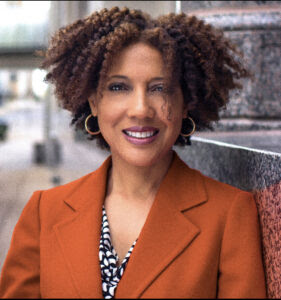 Kathy Times (pictured), university president “Larry Robinson’s hand-picked choice to lead the Office of Communications and to be his official spokeswoman when he was named interim president of Florida A&M University in September 2016, is leaving FAMU,” Cassandra Jean reported Jan. 17 for the Famuan, the student newspaper. Times, a former president of the National Association of Black Journalists, “told The Famuan that she will be leaving her position at the end of the month to continue her own public relations agency in the Tampa area with an office in South Florida near where she grew up. . . .”
Kathy Times (pictured), university president “Larry Robinson’s hand-picked choice to lead the Office of Communications and to be his official spokeswoman when he was named interim president of Florida A&M University in September 2016, is leaving FAMU,” Cassandra Jean reported Jan. 17 for the Famuan, the student newspaper. Times, a former president of the National Association of Black Journalists, “told The Famuan that she will be leaving her position at the end of the month to continue her own public relations agency in the Tampa area with an office in South Florida near where she grew up. . . .”
- “New Jersey will be releasing the remainder of the $235 million in spending Gov. Phil Murphy froze when he signed the state budget in June 2019. This includes the first $1 million of the $2 million earmarked for the Civic Information Consortium, a first-of-its-kind initiative to strengthen local-news coverage and boost civic engagement across the state,” the advocacy group Free Press reported Jan. 16. “This innovative nonprofit, which Free Press Action conceived of and advocated for,. . . will invest in valuable local-news coverage in parts of the state that have become news deserts and will elevate the voices of people of color and others who have been systematically ignored by many media outlets. . . .”
- “On 13th January, Good Morning Britain’s host Piers Morgan invited columnist and author Afua Hirsch to discuss her piece in the New York Times, which cited racism as a major reason for Meghan Markle and Prince Harry’s decision to spread their time across the UK and North America,” begins a Jan. 15 “open letter” from InfluencHer: “a collective of 100 Black British women from the worlds of Media, Law, Health, Education, Publishing and their supporters.” They also wrote, “Having to engage, articulate, and explain racism again and again to predominantly white hosts, white men, and white guests is draining and exhausting. It is frankly traumatizing and wearing to black people who continuously find themselves having to explain the presence and impact of racism to people who refuse to be educated. . . .”
 The Capitol Hill press corps on Friday rallied behind Manu Raju (pictured), CNN’s senior congressional correspondent, after Republican Sen. Martha McSally of Arizona insulted him on Thursday,” Brian Stelter and Oliver Darcy reported Jan. 17 for CNN. They also wrote, “When Raju asked McSally if the Senate should consider new evidence as part of the impeachment trial, she called him a ‘liberal hack,’ adding, ‘I’m not talking to you.’ Her comment was praised and amplified by Trump’s reelection campaign and by right-wing media organizations. . . .”
The Capitol Hill press corps on Friday rallied behind Manu Raju (pictured), CNN’s senior congressional correspondent, after Republican Sen. Martha McSally of Arizona insulted him on Thursday,” Brian Stelter and Oliver Darcy reported Jan. 17 for CNN. They also wrote, “When Raju asked McSally if the Senate should consider new evidence as part of the impeachment trial, she called him a ‘liberal hack,’ adding, ‘I’m not talking to you.’ Her comment was praised and amplified by Trump’s reelection campaign and by right-wing media organizations. . . .”
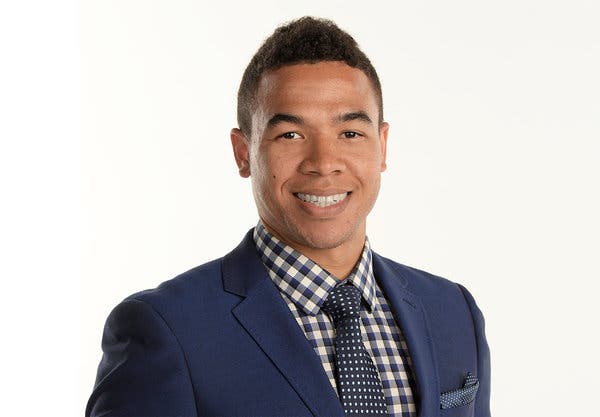 Initial assessments showed that ESPN reporter Edward Aschoff (pictured), who died at 34 on Christmas Eve, succumbed to pneumonia. “But his fiancée Katy Berteau announced on Wednesday that further testing revealed that he had stage 4 non-Hodgkin lymphoma in his lungs,” ason Owens reported Jan. 15 for Yahoo Sports. Owens also wrote, “Aschoff’s [doctors] apparently didn’t know that he was stricken by the cancer until a lung biopsy was completed. . . .”
Initial assessments showed that ESPN reporter Edward Aschoff (pictured), who died at 34 on Christmas Eve, succumbed to pneumonia. “But his fiancée Katy Berteau announced on Wednesday that further testing revealed that he had stage 4 non-Hodgkin lymphoma in his lungs,” ason Owens reported Jan. 15 for Yahoo Sports. Owens also wrote, “Aschoff’s [doctors] apparently didn’t know that he was stricken by the cancer until a lung biopsy was completed. . . .”
- Marcos Santana, Telemundo Global Studios president, and Courtney Kemp, showrunner and creator of the Starz series “Power,” were among honorees at the Brandon Tartikoff Awards in Miami, Cynthia Littleton reported for Variety on Wednesday. Santana said his life’s work has been to “elevate the quality of Spanish-language television” and “to give Latinos (TV) produced by Hispanics for Hispanics.” Kemp, who is African American, called on the crowd to work for greater diversity in all levels of the entertainment industry.
- Dean Steve Coll and the Alumni Association of the Columbia Journalism School announced the recipients of the 2020 Alumni Awards, the school announced Jan. 16. “The winners are Michelle Johnson, ’82 M.S., associate professor, Boston University; Donna Ladd, ’01 M.S., editor in chief and owner, The Jackson Free Press (Mississippi); Natasha Lebedeva, ’94 M.S., director, international affairs, NBC News. The J-School is also presenting the First Decade Award, for graduates of the last 10 years, to Alexandra Bell, ’13 M.S., multidisciplinary artist, and Robert Fieseler, ’13 M.S., author of “Tinderbox: The Untold Story of the Up Stairs and Lounge Fire and the Rise of Gay Liberation.” (W.W. Norton, 2018). . . .”
- “A new PBS documentary is exploring a little-known movement that brought together blacks, Latinos, and poor whites from Appalachia that later resulted in the upending of politics in the American Midwest,” Russell Contreras reported Monday for the Associated Press. ” ‘The First Rainbow Coalition,’ scheduled to begin airing Jan. 27 as part of the Independent Lens series, shows how members of the Black Panther Party organized Puerto Rican radicals and Confederate flag-waving white Southerners to help tackle poverty and discrimination. . . .”
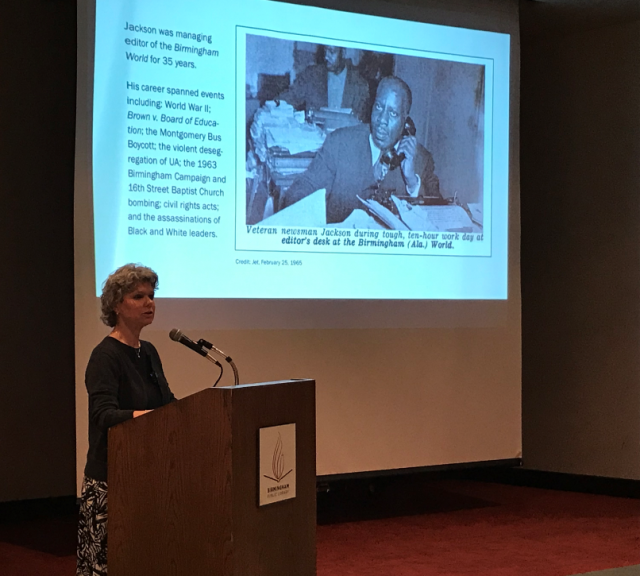
(Credit: Erica Wright, Birmingham Times)
- Kim Mangun, author of “Editor Emory O. Jackson, the Birmingham World, and the Fight for Civil Rights in Alabama, 1940–1975″ delivered the 17th annual Martin Luther King Jr. Memorial Lecture at the Birmingham Public Library, Barnett Wright wrote Monday for the Birmingham Times in Alabama.
“In many ways, Jackson was a journalist ahead of his time, Mangun said. The crusading editor kept detailed records of officer involved shootings, she said.
“Today websites like MappingPoliceViolence.org and media organizations including the Washington Post compile data on officer involved shootings much as Jackson did beginning in the early 1940s with the limited resources available to him,” Mangun said. “. . . Jackson wrote extensively about violence in Birmingham during the 1940s, 1950s, 1960s when there were 34 bombings plus seven frightening near misses of black owned homes, businesses and churches. . . . He edited the Birmingham World until September 10, 1975, when he died at the age of 67. . . .”
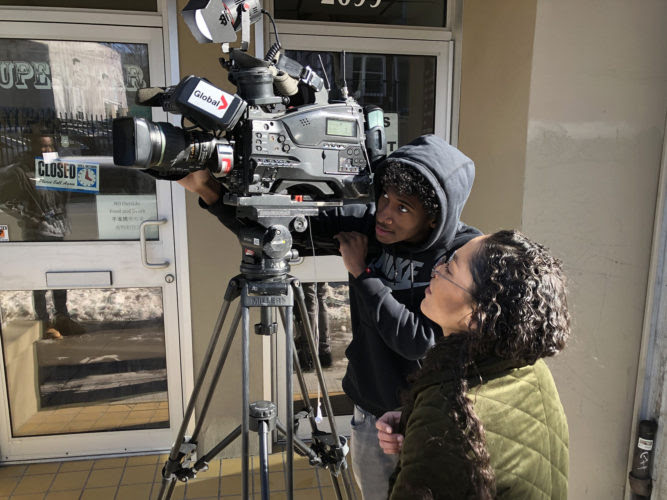
- The Canadian Association of Black Journalists is hosting a one-day media training session for black junior high and high school students, an inaugural seminar for J-School Noire, on Feb. 25 in Dartmouth, Nova Scotia, Lesli Tathum reported Jan. 17 for the Signal at the University of King’s College. “‘J-School Noire is about giving a voice to black youth and giving them the skills necessary to tell their stories right now,” Brian Daly, the CABJ Atlantic director, said in an interview. “Not in 10 years or when they’re in their 20s, but right now.” After a J-School Noire seminar in Halifax, the CABJ is looking to expand to Toronto, Ottawa, Vancouver and Montreal.
- Investigative Reporters and Editors is hosting a Watchdog Workshop on Friday, Feb. 7, in Puerto Rico. “These sessions are designed for reporters, editors, and producers from small, midsize and large publications, TV, radio stations, Web-only news sites and news blogs. Freelancers, students and journalism educators are also encouraged to attend,” the organization says.
- The Reporters Committee for Freedom of the Press announced Tuesday it will “launch its Local Legal Initiative this year in Colorado, Oklahoma, Oregon, Pennsylvania and Tennessee to provide pro bono legal support to local journalists and news outlets throughout the states pursuing enterprise and investigative journalism. The initiative follows a $10 million investment from the John S. and James L. Knight Foundation announced last year as part of the foundation’s pledge to double its commitment to strengthening local journalism.”
- “Statistics from 2017 show that Hispanics make up 17% of the labor force,” JD Swerzenski, Donald T. Tomaskovic-Devey and Eric Hoyt of the University of Massachusetts Amherst wrote Wednesday for the Conversation. “However, they occupy only 4.3% of executive positions in the U.S. Hispanic representation is roughly equal to that of black executives and somewhat lower than Asian American executives. The gap between labor force and executive representation is wider among Hispanics than any other group. . . .”
- “A powerful exposé of negligence by the largest private contractor of prison health care, and a series examining the plight of indigenous Alaskans living with no police protection are the winners of the nation’s most prestigious award for justice journalism. [PDF] . . . John Jay College/Harry Frank Guggenheim awards for Excellence in Criminal Justice Reporting have been awarded to Blake Ellis and Melanie Hicken of CNN, and Kyle Hopkins of the Anchorage Daily News,” the school announced Jan 17.
- “Pinterest published its sixth annual diversity report today and it’s encouraging on several fronts,” Ellen McGirt reported Jan. 16 for Fortune. “It hit a milestone this year: The company has exceeded all three of its stated goals for hiring women and underrepresented minority employees. . . .”
- In Massachusetts, a “bill by Jack Flanagan, a Brookline Republican, would require news outlets to update all online articles about people in the judicial system if they were acquitted, found not guilty, or had their charges dropped,” Ethan DeWitt reported Jan. 15 for the Concord (N.H.) Monitor.

- The Nieman Foundation for Journalism at Harvard announced Jan. 16 it had selected eight media innovators as the 2020 Knight Visiting Nieman Fellows. They are: Mercy Adhiambo, a features writer at the Standard in Kenya; Nicole Barton, an audience development associate at KQED in San Francisco; Erika Dilday, executive director of the Futuro Media Group; Wendy Lu, an editor and producer for HuffPost; Tomer Ovadia, a software engineer at Google; Amy Silverman, a freelance journalist and advisory board member of the National Center on Disability and Journalism; Elizabeth Toohey, assistant professor of English at Queensborough Community College, City University of New York; and Lewis Raven Wallace, a freelance journalist and co-founder and national program director of Press On, a Southern collective for movement journalism, which focuses on liberation and racial justice issues.
- Natasha Alford, deputy editor of theGrio.com, has been named vice president of digital content for TheGrio digital network platform, Mark K. Miller reported Jan. 16 for TVNewsCheck. “In her new position, Alford will continue to be based at the Entertainment Studios offices in New York.”
- C-SPAN 3, the American History Channel, is airing a talk by historian Michael Searles on “Black Cowboys in the American West: On the Range, on the Stage, Behind the Badge” on Saturday at 9:05 p.m. ET. “We see images of black cowboys as Professor Searles discusses their experiences from the early 19th century to the present day,” the network says.
- “In a move criticized by press freedom organizations, U.S. journalist Glenn Greenwald was charged by the Federal Public Prosecutor (MPF, for its acronym in Portuguese) for alleged involvement with hackers who accessed messages exchanged through the Telegram application by various authorities, such as Minister of Justice Sergio Moro and prosecutor Deltan Dallagnol, who leads the task force for Operation Car Wash, Júlio Lubianco and Marina Estarque reported Tuesday for the Knight Center for Journalism in the Americas. “In a video posted on Twitter, Greenwald said that attorney Wellington Divino de Oliveira, who signed the charges, ‘is abusing his position to attack political enemies.’ . . .”
- In Haiti, “many journalists report working in dangerous and even life-threatening conditions.” Chantal Flores reported Jan. 17 for Columbia Journalism Review. “Public perception of journalism has deteriorated; protestors accuse media outlets of supporting the government, and attacks on the press have escalated. Journalists are also harassed by counter-protesters and police from the opposing side. They report physical attacks, death threats, and defamation campaigns on social media. . . .”
- Authorities in Nigeria should conduct a swift and credible investigation into the killing of Maxwell Nashan, a reporter and newscaster with the government-owned Federal Radio Corporation of Nigeria (FRCN), and determine whether his journalism was the motive for the attack,” the Committee to Protect Journalists said Thursday. “Farmers found Nashan bound and gagged in Badarisa in the early hours of January 15, about 2 km from the FRCN office and about 3 km from his home. . . .”
- Juan Sánchez Moreno, who was commander of the Attorney General’s Office of the state of Puebla, was convicted on Jan. 15 for the crime of torture against Mexican journalist Lydia Cacho, which occurred in 2005, according to freedom of expression organization Article 19 Mexico,” Silvia Higuera wrote Jan. 17 for the Knight Center for Journalism in the Americas. “Sánchez Moreno must serve five years and three months in prison, and pay a fine of 12,133 Mexican pesos (approximately US $644), the site Infobae reported. ‘This sentence contains a penalty that does not address the seriousness of the acts of torture or the command post occupied by Sánchez Moreno,’ Article 19 wrote via Twitter. . . .”
Facebook users: “Like” “Richard Prince’s Journal-isms” on Facebook.
Follow Richard Prince on Twitter @princeeditor
Richard Prince’s Journal-isms originates from Washington. It began in print before most of us knew what the internet was, and it would like to be referred to as a “column.” Any views expressed in the column are those of the person or organization quoted and not those of any other entity. Send tips, comments and concerns to Richard Prince at journal-isms-owner@yahoogroups.com
View previous columns (after Feb. 13, 2016).
- Diversity’s Greatest Hits, 2018 (Jan. 4, 2019)
- Book Notes: Is Taking a Knee Really All That? (Dec. 20, 2018)
- Book Notes: Challenging ’45’ and Proudly Telling the Story (Dec. 18, 2018)
- Book Notes: Get Down With the Legends! (Dec. 11, 2018)
- Journalist Richard Prince w/Joe Madison (Sirius XM, April 18, 2018) (podcast)
- Richard Prince (journalist) (Wikipedia entry)
- February 2018 Podcast: Richard “Dick” Prince on the need for newsroom diversity (Gabriel Greschler, Student Press Law Center, Feb. 26, 2018)
- Diversity’s Greatest Hits, 2017 — Where Will They Take Us in the Year Ahead?
- Book Notes: Best Sellers, Uncovered Treasures, Overlooked History (Dec. 19, 2017)
- An advocate for diversity in the media is still pressing for representation, (Courtland Milloy, Washington Post, Nov. 28, 2017)
- Morgan Global Journalism Review: Journal-isms Journeys On (Aug. 31, 2017)
- Diversity’s Greatest Hits, 2016
- Book Notes: 16 Writers Dish About ‘Chelle,’ the First Lady
- Book Notes: From Coretta to Barack, and in Search of the Godfather
- Journal-isms’ Richard Prince Wants Your Ideas (FishbowlDC, Feb. 26, 2016)
- “JOURNAL-ISMS” IS LATEST TO BEAR BRUNT OF INDUSTRY’S ECONOMIC WOES (Feb. 19, 2016)
- Richard Prince with Charlayne Hunter-Gault,“PBS NewsHour,” “What stagnant diversity means for America’s newsrooms” (Dec. 15, 2015)
- Book Notes: Journalists Follow Their Passions
- Book Notes: Journalists Who Rocked Their World
- Book Notes: Hands Up! Read This!
- Book Notes: New Cosby Bio Looks Like a Best-Seller
- Journo-diversity advocate turns attention to Ezra Klein project (Erik Wemple, Washington Post, March 5, 2014)
Columns below from the Maynard Institute are not currently available but are scheduled to be restored soon on journal-isms.com.
- Book Notes: “Love, Peace and Soul!” And More
- Book Notes: Book Notes: Soothing the Senses, Shocking the Conscience
- Diversity’s Greatest Hits, 2015
- Diversity’s Greatest Hits, 2014
- Diversity’s Greatest Hits, 2013
- Diversity’s Greatest Hits, 2012
- Diversity’s Greatest Hits, 2011
- Diversity’s Greatest Hits, 2010
- Diversity’s Greatest Hits, 2009
- Diversity’s Greatest Hits, 2008
- Book Notes: Books to Ring In the New Year
- Book Notes: In-Your-Face Holiday Reads
- Fishbowl Interview With the Fresh Prince of D.C. (Oct. 26, 2012)
- NABJ to Honor Columnist Richard Prince With Ida B. Wells Award (Oct. 11, 2012)
- So What Do You Do, Richard Prince, Columnist for the Maynard Institute? (Richard Horgan, FishbowlLA, Aug. 22, 2012)
- Book Notes: Who Am I? What’s Race Got to Do With It?: Journalists Explore Identity
- Book Notes: Catching Up With Books for the Fall
- Richard Prince Helps Journalists Set High Bar (Jackie Jones, BlackAmericaWeb.com, 2011)
- Book Notes: 10 Ways to Turn Pages This Summer
- Book Notes: 7 for Serious Spring Reading
- Book Notes: 7 Candidates for the Journalist’s Library
- Book Notes: 9 That Add Heft to the Bookshelf
- Five Minutes With Richard Prince (Newspaper Association of America, 2005)
- ‘Journal-isms’ That Engage and Inform Diverse Audiences (Q&A with Mallary Jean Tenore, Poynter Institute, 2008)
